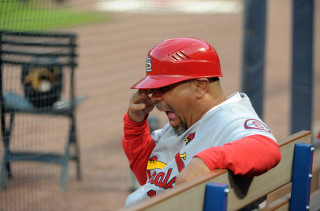
The commissioner of Major League Baseball yesterday had more suggestions for speeding up baseball to make it more appealing to short-attention-span nation.
Rob Manfred said the sport doesn’t “need to be fixed,” but focus groups have told him all the dead-ball time is turning them off.
He pointed to a couple of small changes which will make very little difference — intentional walks by declaration and less time for managers to decide whether to call for a replay, but he also revealed — without actually saying so — what the real problem is: Umpires.
“We have data on how effective the batters handle that low strike and that is something that has driven our thinking,” Manfred said. “I think it’s also important to remember the evolution on the strike zone. The strike zone was down to the hollow of the knee because we weren’t getting low strikes called. My good friend Mr. [Sandy] Alderson [then executive vice president of operations for MLB] came along and he improved dramatically the management of the umpires in two ways. We had a lot of turnover, we got a younger group there, and even more importantly, he applied technology to the strike zone. As that younger group grew up with that technology, they started calling that low strike, and the change we’re suggesting from my perspective is sort of like restoring the natural order, getting back to where we were for a very long time.”
He’s suggesting a smaller strike zone, the bottom of which would be just above the knee.
Would that help? There’s nothing more exciting than watching batters not swing at pitches to try to get a walk.
Manfred also said the rule-change in rookie leagues, allowing teams to start extra innings with a runner on second base, probably won’t ever make it to the big leagues.
“In Rookie ball, where crowds are small and games are really developmental, starting the 10th inning with a runner on base makes sense because there’s really no developmental reason to play 18 innings and end with the shortstop pitching,” he said. “And who knows? If we remain open-minded, we may learn something from this experiment that’s helpful moving forward.”
And Manfred acknowledged younger people today want different entertainment than what baseball has traditionally offered.
“The reality is consumers’ behavior is changing very rapidly,” Manfred said. “It’s an issue that faces every major enterprise that’s involved in the entertainment business.”
And he said getting rid of the blackout rule for watching games on smartphones and computers — local fans can’t watch their local team’s games — makes sense.
“I think that’s a really important way for particularly younger fans to enjoy our games on an important platform,” Manfred said.
The league reached an agreement with some regional TV sports networks to eliminate the blackout. So, all but nine teams won’t be blacked out locally anymore.
The Twins aren’t one of them, but fans will still need to be cable TV subscribers and be subscribers to FoxSports North to be able to watch the local squad.
At a time when younger people are “cutting the cord”, that’s not a logical solution.
